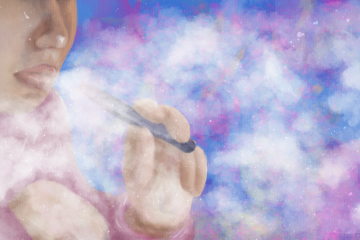
WALKING INTO her room exhausted, Johanna Gee comes home from work as the dawn breaks. The working student sits by her computer table before she rests, noting the hours of sleep she might have before her academic responsibilities start.
On the same morning, Marvin Mangubat wakes up in his Pampanga home. He gathers himself after a year of academic leave, readying himself to return to campus, online.
Two others in Manila prepare themselves for the day’s activity. Rhana Louise prepares for zoom classes and group meetings while Jiego Tagaban prepares for his student council responsibilities.
The Artlets’ responsibilities come together in a computer screen: two years of experience logged into PCs, laptops, and in Jiego’s case, a borrowed phone.
Since Metro Manila was placed under Alert Level 2, CHED allowed the resumption of limited face-to-face classes in all college degree programs. The University has no announcements yet, as of writing.
With more than a year into online classes, The Flame checks in on four Artlets to share their experience in online learning. Each story paints a picture of student struggles and most importantly, the culture of care.
Missing Boundaries
Third-year political science student and San Lorenzo Ruiz scholar Rhana Abucejo reflects on the difficulty of doing academic work due to home responsibilities. Between their duty at home and in school, Rhana needs to provide childcare for their younger cousins who need supervision. Because of this, Rhana has little choice but to do schoolwork in the dead of night.
“Before the pandemic, I can manage my own time. [Like how] after my library duties, I can choose to rest. Back then, I can set my own pace,” They say while children are heard playing in the background.
Second-year literature SWIS Marvin Mangubat parallels Rhana’s sentiment by pointing out how face-to-face classes offered a sanctuary from unstable households. However, this reprieve isn’t present in an online setting.
Both Rhana and Marvin use the term “heavier” to describe online classes, explaining that online learning lacks the social aspect of learning.
“We don’t really have classmates to relate to during online classes,” Marvin shares. “We can help each other online, but it’s not the same. We can’t really hug and comfort each other this way. I mean, how do you console a phone?”
Struggles
On top of being a student with irregular subjects, Johanna also works to support herself and her family.
During the start of the pandemic, Johanna’s parents and sister lost their jobs.
“I said to myself, ‘I need to step up; I have to step up […] I have to help my family,’” Johanna says. She then filed for a leave of absence (LOA) last year and worked as a call-center agent.
She reflects, “When I was a regular student, all I had to think [about] was studying […], but now I have to think about how much [money] would I have to earn to [help] my family.”
The economic loss that intersects with personal losses weighs heavily on Johanna’s mind.
In the mismanagement of the pandemic, Marvin shares similar sentiments to Johanna as he lost a loved one to covid.
“I remember the heartbreaking sound [as] my [paternal] grandfather took his last breath [due to COVID-19]. The weeks after that broke my spirit for online classes,” Marvin explains, revealing his reason for not enrolling last school year.
“I think the hardest part is knowing this happened because of a government that didn’t do its job,” Marvin adds.
Acknowledging these struggles, the university attempted to ease hardships through academic breaks.
READ: AB suspends synchronous classes from Sept. 22-25
Rhana points out the professors’ difficulties in adjusting, which is something that Jiego echoes. As a student leader, Jiego pushed for an academic break while acknowledging it as a short-term solution.
Some students and faculty members, however, had concerns about the frequent academic breaks, noting that they have disrupted schedules and have resulted in the piling up of school requirements.
A Culture of care
Despite the pressures accompanying online classes, Artlets find inspiration from each other to continue the community they left on campus.
“We lost the culture of care we cultivated before the pandemic,” Jiego says. “Moving forward, we should heal by practicing it again, a culture that I try to help with my council platforms.”
Despite the struggles he had to overcome, Jiego found a place in this academic year’s AB Student Council as the treasurer. “We are more than thankful that [Artlets] have tried to live and not just survive, especially with these evidently worsening circumstances,” he says.
Johanna sends a more personal note to the people who helped her since the start of the pandemic. “Thank you to the current 3LIT,” she says.
Rhana shares a simple sentiment that aims to comfort students, saying, “Uy, kapit lang; magkakasama tayo.”
Although socially distanced, the culture of care lives on in the online hugs of every Artlet. Hopeful for the culture of care to be stronger than ever, Jiego says, “We shall do it together.” F – Lila Victoria Reyes



